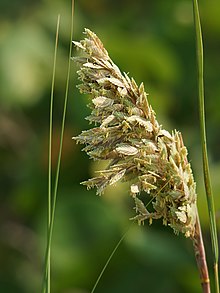This article needs additional citations for verification. (December 2009) |
| Sea oats | |
|---|---|

| |
| Scientific classification | |
| Kingdom: | Plantae |
| Clade: | Tracheophytes |
| Clade: | Angiosperms |
| Clade: | Monocots |
| Clade: | Commelinids |
| Order: | Poales |
| Family: | Poaceae |
| Genus: | Uniola |
| Species: | U. paniculata
|
| Binomial name | |
| Uniola paniculata | |
Uniola paniculata, also known as sea oats, seaside oats, araña, and arroz de costa,[1] is a tall subtropical grass that is an important component of coastal sand dune and beach plant communities in the southeastern United States, eastern Mexico and some Caribbean islands.
Its large seed heads that turn golden brown in late summer give the plant its common name.
Its tall leaves trap wind-blown sand and promote sand dune growth, while its deep roots and extensive rhizomes act to stabilize them, so the plant helps protect beaches and property from damage due to high winds, storm surges and tides.
It also provides food and habitat for birds, small animals and insects.[1]
- ^ a b Hazell, J., Brown, S.H. and Cooprider, K., Univ. of Florida, IFAS Extension, Lee County, Southwest Florida. "Uniola paniculata" (PDF). Archived from the original (PDF) on 2017-06-30. Retrieved 2014-11-28.
{{cite web}}: CS1 maint: multiple names: authors list (link)